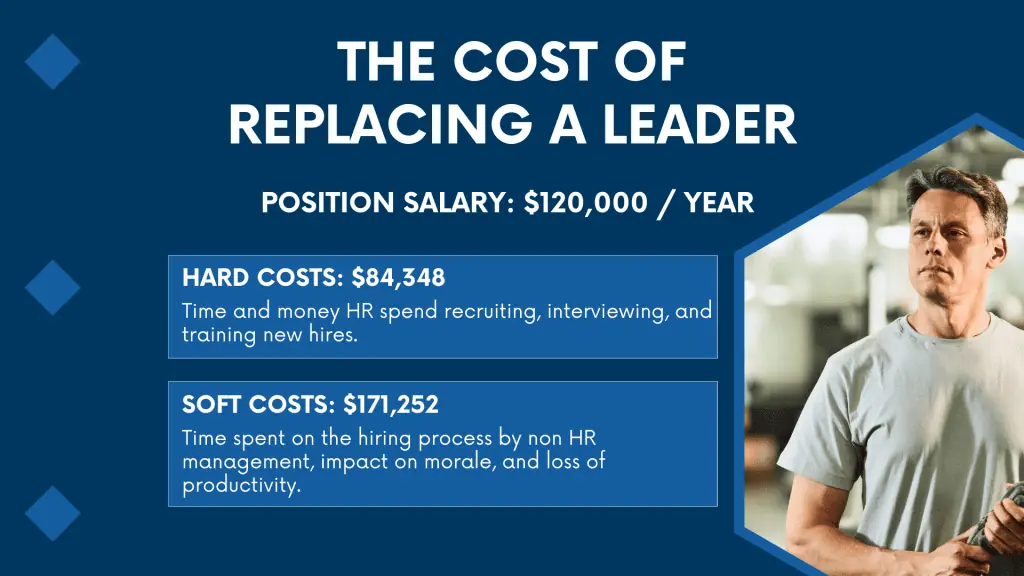Employee turnover is a constant battleground for businesses across all industries. While losing any employee can be disruptive, the departure of leaders can trigger a domino effect with far-reaching consequences. This blog post delves into the hidden and not-so-hidden costs associated with turnover, particularly regarding leadership positions.
We’ll explore the financial impact, the drain on productivity, and the intangible costs that erode morale and damage a company’s reputation. We’ll also shed light on the difference between hard and soft costs, providing a clearer picture of the actual financial burden of turnover.

The Staggering Price Tag of Turnover
Studies reveal a sobering reality: Replacing an employee can cost a company anywhere from one-half to two times their annual salary. This figure can balloon to 213% of the salary for C-suite departures. Let’s unpack this cost further by differentiating between hard and soft costs.
- Hard Costs are the tangible expenses directly associated with replacing an employee. They include:
- Recruiting and hiring: Advertising, candidate screening, background checks, and HR salaries all contribute to this cost. The Society for Human Resource Management (SHRM) reports the average cost per hire to be $4,700, but this number can rise significantly depending on the position.
- Training and onboarding: Integrating a new leader into the company culture and ensuring they possess the necessary skills requires time and resources. Onboarding costs for larger companies can exceed $3,000 per employee.
- Soft Costs: These are the indirect and often underestimated expenses associated with turnover. They include:
- Lost productivity: New hires take time to ramp up. Studies show it can take 3 to 8 months for an employee to become fully productive. In leadership roles, this lost productivity translates to missed deadlines, delayed projects, and potential revenue losses.
- Decreased morale: When a leader leaves, it can create a sense of uncertainty and instability among remaining employees. This can lead to reduced morale, lower engagement, and potentially a domino effect of further departures.
- Damaged reputation: High turnover paints a negative picture of a company’s culture. This can make attracting and retaining top talent more challenging, creating a vicious cycle.
- Time spent by non-HR management: Managers and supervisors must often take a significant role in hiring new candidates. This time spent on interviewing, reviewing, and onboarding takes away from them performing their duties, leading to a loss of productivity.

Leadership Turnover: A Ripple Effect
The impact of a leader’s departure extends far beyond the immediate team. Consider these additional factors:
- Loss of Institutional Knowledge: Experienced leaders possess a wealth of knowledge about the company’s history, strategy, and client relationships. Losing this knowledge creates a gap that takes time and resources to fill.
- Disruption of Team Dynamics: Effective leadership fosters a sense of trust and collaboration. When a leader leaves, it can disrupt these dynamics and create a period of adjustment for the entire team.
- Customer Impact: High-level leaders often have direct client relationships. Their departure can lead to service disruptions and potentially damage customer loyalty.
As mentioned, a leader’s departure can trigger a domino effect that cascades through the organization, significantly increasing replacement costs. Direct reports, feeling close to their leader, may be more likely to follow them to a new opportunity. Furthermore, the remaining team members, needing more clear direction and guidance in the leader’s absence, may experience decreased morale and productivity, all while being forced to work overtime (another added cost to the company). This can lead to a decline in performance, missed deadlines, potential customer dissatisfaction, and potentially more departures. All of these issues compound and necessitate additional resources to rectify. Ultimately, losing a single leader can trigger a chain reaction of departures and performance issues, driving costs far beyond the initial replacement expense.

Leadership Retention: The Ultimate Guide
Dive deeper into leadership retention with Inflection Poynt’s ultimate guide! This comprehensive resource explores the challenges and opportunities of retaining top environmental service leaders. Packed with actionable insights, data-driven strategies, and practical tips, take a look today!
The Inflection Poynt Difference
Inflection Poynt isn’t just another recruiting agency. We understand the long-term value of building a stable workforce. That’s why our candidate sourcing strategies prioritize finding qualified individuals and those who demonstrate a strong cultural fit and a commitment to long-term career growth. Our commitment to retention-focused hiring means you can be confident you’re not just filling a vacancy. You’re investing in building a team that thrives within your company culture and contributes to its success for years.
Contact us today to learn how we can provide you with qualified and retention-focused leaders!



